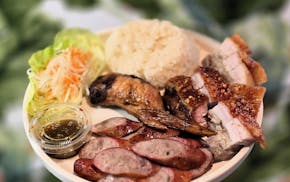BROOTEN, Minn. – When the folks at Redhead Creamery are crafting their artisan cheeses, they now have liquor in mind. And for good reason.
As award-winning cheeses such as Margie Cheddar and North Fork Whiskey Washed Munster are produced, only about 10% of the milk actually becomes cheese. The rest is whey, a yellowish liquid that can be further broken down into protein — which can be fed to cows or sold commercially for humans — and sugar.
For the first time last week, Redhead Creamery owners turned that sugar into a spirit called araga, a clear liquor that's less harsh than whiskey, rye or even vodka.
"It tastes like vodka, but creamy. There's some softness to it," said Lucas Sjostrom, who runs the creamery with his wife, Alise, and her parents, Jerry and Linda Jennissen.
For centuries, people around the world have been creating alcohol by fermenting milk, but the process of distilling whey into a specialty liquor is fairly recent, with a smattering of whey-based spirits coming onto the market in the past decade. Those include Vodkow Vodka from Ontario, Wheyward Spirit from California and Copper Crow from Bayfield, Wis.
But the product is still incredibly rare, with industry experts estimating there are fewer than two dozen distilleries worldwide making whey-based spirits. Lucas Sjostrom attributes this to the inefficiency of using whey compared with grain when making alcohol, and the lack of availability of whey for many distillers.
"You pretty much have to have a cheese plant and get free whey," said Sjostrom, 37. "But we have a source and we love bringing dairy to life."
The creamery-made aragas and vodkas are now for sale at the venue's tasting room, which also recently started serving burgers, cheese flights and desserts. The cocktail menu has seven specialty drinks, many using araga, and all are garnished with one of Redhead's artisan cheeses.
Decades of dairy love
The creamery owners' love for all things dairy started decades ago. Jerry and Linda Jennissen met at a county calf show and, after they were married, moved to a farm just north of the current creamery in 1979. That first winter, they stumbled upon the creamery property while cross-country skiing.
"It was an abandoned property. They stood just north of the creamery here and said, 'This would be a cool place to raise our family. This would be a cool place to raise cows,'" Sjostrom said. "They just thought this was so idyllic."
The couple bought 40 acres of the farm in 1983 and have since restored it to its original 300 acres.
Lucas and Alise also met through dairy, at a Junior Holstein Association convention. They started dating at the University of Minnesota, where Lucas was majoring in animal sciences and Alise in dairy food quality.
Alise, 38, also participated in the Princess Kay of the Milky Way contest and was known by her friends as "Cheese Alise."
"I had high school friends who called me that," she said with a laugh. "They would always tease me because I was always very promotional of drinking your milk and eating your cheese."
Alise said she knew in high school that she wanted to someday open an artisan cheese company. While living in Vermont for a few years, Alise worked at Grafton Village Cheese Co. That helped convince Lucas to get on board.
"Within her first few weeks of work, she sent cheese to George H.W. Bush, John Travolta and the CEO of Disney/Pixar at the time. And I was like, 'Oh, people buy this stuff,'" he said. "We had no friends. We had no kids. We had no family. So we just started going to cheese companies and breweries every weekend and etching out a business plan."
They moved back to Minnesota in 2012 to start a family and, shortly afterward, an artisan cheese-making business. Lucas is also the executive director of the Minnesota Milk Producers Association, where he advocates for dairy farmers across the Midwest.
While the farmstead cheese company was Alise's dream, adding spirits was all Lucas. He said he first saw a story about people turning whey into alcohol in 2011.
"I probably drank Busch Light at the time and probably didn't know what spirits were," he said. "But I think we can make as much revenue out of our cheese vat from the cheese side as we can on the spirits side."
Over the past decade, Lucas has taken distilling courses and visited nearly 200 distilleries across the country.
"It's a community just like the cheese community," he said. "If you say, 'I'm going to be a distiller,' they're like, 'Come on back! Here are all the things I don't tell on the tour.' It was very valuable."
The science behind it
So how does whey become araga? After the cheese-making process, the remaining whey is run through a filter to separate the protein from sugar. Lactase is added to break down the sugar and yeast is added to convert the glucose to alcohol.
At this stage of the process, the liquid is "Mountain Dew yellow" and tastes similar to a cider beer. That liquid is then heated through the distillation process. The final product is about 40% alcohol.
"This is by no means a new technology," Lucas said. "But what they figured out over the past 70 years is the protein part is the valuable part [of whey] worldwide. What we're doing is the opposite. We're saying, let's give the protein to the cows and let's turn the sugar into alcohol."
Redhead Creamery, 31535 463rd Av., Brooten, Minn., redheadcreamery.com. Tasting room and cheese shop open 11 a.m.-4 p.m. Thu.-Fri., 11 a.m.-5 p.m. Sat.; farm tours available at 12:30 p.m. Fri.-Sat.

Critics' picks: The 11 best things to hear, do and see in the Twin Cities this week

Critics' picks: The 9 best things to do and see in the Twin Cities this week

The 5 best things our food writers ate this week

The 5 best things our food writers ate this week



